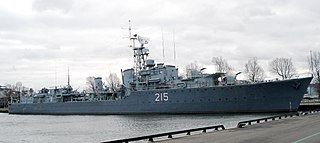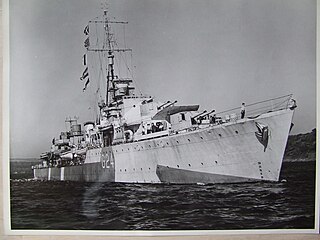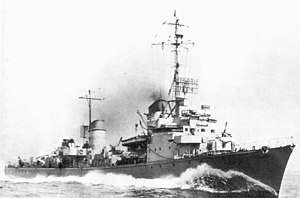
HMCS Haida is a Tribal-class destroyer that served in the Royal Canadian Navy (RCN) from 1943 to 1963, participating in World War II and the Korean War. She was named for the Haida people.

The Tribal class, or Afridi class, were a class of destroyers built for the Royal Navy, Royal Canadian Navy and Royal Australian Navy that saw service in World War II. Originally conceived during design studies for a light fleet cruiser, the Tribals evolved into fast, powerful destroyers, with greater emphasis on guns over torpedoes than previous destroyers, in response to new designs by Japan, Italy, and Germany. The Tribals were well admired by their crews and the public when they were in service due to their power, often becoming symbols of prestige while in service.

HMCS Huron was a Tribal-class destroyer that served in the Royal Canadian Navy in the Second World War and the Korean War. She was the first ship to bear this name, entering service in 1943. She was named for the Huron people. During the Second World War the vessel saw service in Operation Neptune in the Bay of Biscay and along the French coast in support of the invasion of Normandy and escorted convoys to the Soviet Union. Following the war, the ship was placed in reserve. The destroyer was activated in 1950 as a training ship, but with the onset of the Korean War, was modernized and deployed twice to Korea. Following the war, Huron reverted to a training ship and took part in Cold War-era North Atlantic Treaty Organization (NATO) naval exercises until being paid off for the final time in 1963 and broken up for scrap in 1965.

Z21 Wilhelm Heidkamp was one of six Type 1936 destroyers built for the Kriegsmarine in the late 1930s. Completed a few months before the start of World War II in September 1939, the ship served as a flagship throughout her career. She briefly patrolled the Skagerrak where she inspected neutral shipping for contraband goods. Z21 Wilhelm Heidkamp later helped to lay four offensive minefields off the English coast that claimed two British destroyers, 2 fishing trawlers, and twenty-seven merchant ships. During the German invasion of Norway in April 1940, she sank a Norwegian coastal defense ship off Narvik and was crippled with the opening shots of the First Naval Battle of Narvik on 10 April, with the loss of 81 crewmen. The ship sank the following day.

Z23 was one of fifteen Type 1936A destroyers built for the Kriegsmarine during World War II. Completed in 1940, the ship spent the war in Norwegian and French waters, escorting German ships and occasionally engaging Allied warships. In early 1941 she escorted ships between the Baltic and southern Norway before spending four months protecting ships as they transited through the Bay of Biscay. A few months after the Operation Barbarossa began in June, Z23 was transferred to northern Norway where she attempted to intercept one of the Arctic convoys returning from the Soviet Union and helped to lay several minefields.

The German torpedo boat T25 was one of fifteen Type 39 torpedo boats built for the Kriegsmarine during World War II. Completed in late 1942, she was transferred to France in July 1943. T25 was unsuccessfully attacked by Allied motor torpedo boats and aircraft during her voyage down the English Channel and then came to the aid of a convoy being attacked by Allied destroyers. Later that year she escorted blockade runners and Axis submarines through the Bay of Biscay. T25 also helped to lay minefields in the English Channel in mid-1943. She participated in the Battle of Sept-Îles in October and was sunk two months later by British light cruisers during the Battle of the Bay of Biscay.

The German torpedo boat T26 was one of fifteen Type 39 torpedo boats built for the Kriegsmarine during World War II. Completed in early 1943, the boat was transferred to France in August. T26 helped to lay a minefield in the English Channel the following month, and later escorted a blockade runner through the Bay of Biscay. She participated in the Battle of Sept-Îles in October and was sunk two months later by a British light cruiser during the Battle of the Bay of Biscay.

ZH1 was the lead ship of her class of four destroyers built for the Royal Netherlands Navy in the late 1930s. Originally named Gerard Callenburgh, the ship was scuttled while still incomplete by the Dutch during the German invasion of the Netherlands in May 1940, but she was salvaged by the Germans a few months later and commissioned in the Kriegsmarine in 1942 as ZH1.

Z32 was a German Type 1936A (Mob) destroyer, which was completed in 1942 and which served with the 8th Destroyer Flotilla of the Kriegsmarine during the Second World War. She fought in the Battle of the Bay of Biscay against HMS Glasgow and HMS Enterprise, alongside the German 8th Destroyer Flotilla and the 4th Torpedo Boat Flotilla. She mainly operated from German-occupied French Atlantic ports, escorting blockade runners and U-boats, and was sunk during the Battle of Ushant on 9 June 1944.

Z37 was a Type 1936A (Mob) destroyer built for the Kriegsmarine during World War II. Completed in 1942, the ship spent most of her brief career deployed in France. She participated in the Battle of the Bay of Biscay at the end of 1943 before she was accidentally rammed by the destroyer Z32 in early 1944. Towed back to port, the Kriegsmarine decided that Z37 was too badly damaged to repair and disarmed her hulk. Decommissioned later that year, she was scuttled by her crew before being scrapped by the French in 1949.

NMS Mărăști was one of four Vifor-class destroyers ordered by Romania shortly before the beginning of the First World War from Italy. All four sister ships were requisitioned when Italy joined the war in 1915. Originally named Vijelie by the Romanians, she was renamed Sparviero in Italian service. Not completed until mid-1917, the ship engaged Austro-Hungarian ships in the Adriatic Sea only twice before the war ended in November 1918. She was given a new name as Mărăști when she was re-purchased by the Romanians in 1920.

The German torpedo boat T21 was one of nine Type 37 torpedo boats built for the Kriegsmarine during World War II. Completed in mid-1942, she was transferred to Norway in March 1943 for escort duties. The ship returned to Germany in October and was assigned to the Torpedo School. T21 returned to active duty in May 1944 and supported German forces operating in the Baltic Sea. The boat began a major refit in December which had not been completed when the war ended in May 1945. She was allocated to the United States after the war, but was only used to dispose of gas munitions by scuttling her in deep water in 1946.

The Type 1939 torpedo boats, also known as the Elbing class by the Allies, were a group of 15 torpedo boats that were built for Nazi Germany's Kriegsmarine during World War II.

The German torpedo boat T31 was one of fifteen Type 39 torpedo boats built for the Kriegsmarine during World War II. Completed in early 1944, the boat was assigned to convoy escort duties and supporting German forces in the Baltic. She was sunk in combat with Soviet motor torpedo boats on 20 June off the Finnish coast on 20 June with 82 men killed.

The German torpedo boat T30 was one of fifteen Type 39 torpedo boats built for the Kriegsmarine during World War II. Completed in late 1943, the boat was assigned to support German operations in the Baltic Sea. She laid minefields in the Gulf of Finland, off the Estonian coast, in mid-April, before she was tasked to support Finnish forces in June. The following month, T30 helped to sink a Soviet patrol boat. After a navigational error caused her to enter a German minefield as she was preparing to lay one herself in August, the boat sank after striking several mines with the loss of 137 crewmen.

The German torpedo boat T24 was one of fifteen Type 39 torpedo boats built for the Kriegsmarine during World War II. Completed in 1942, the boat was briefly assigned to Norway in early 1943 before she was transferred to France in July. T24 was unsuccessfully attacked by Allied motor torpedo boats and aircraft during her voyage down the English Channel and then came to the aid of a convoy being attacked by Allied destroyers. Later that year she escorted blockade runners and Axis submarines through the Bay of Biscay. The boat played a minor role in the Battle of the Bay of Biscay and was lightly damaged during the action of 26 April 1944. During the subsequent battle, T24 sank a Canadian destroyer and was damaged when she later struck a mine. She played a minor role in the Battle of Ushant in June and was then damaged defending a convoy in August in the Bay of Biscay. T24 was sunk off the French coast later that month by Allied fighter-bombers.

The German torpedo boat T28 was one of fifteen Type 39 torpedo boats built for the Kriegsmarine during World War II. Completed in mid-1943, the ship was transferred to France in January 1944 and slightly damaged by British aircraft en route. She attacked Allied ships during the Invasion of Normandy in June 1944 and returned to Germany the following month. T28 was assigned to support German operations in the Baltic Sea. She escorted convoys and larger warships bombarding Soviet troops as well as bombarding them herself. In May T28 helped to evacuate troops and refugees from advancing Soviet forces. The ship was allocated to Great Britain after the war, but she was transferred to France in 1946. The French Navy renamed her Le Lorrain and recommissioned her in 1949. After serving with different units of the Mediterranean Squadron, she was condemned in 1955 and subsequently sold for scrap.

The German torpedo boat T27 was one of fifteen Type 39 torpedo boats built for the Kriegsmarine during World War II. Completed in early 1943, the boat was transferred to France in August. T27 helped to lay a minefield in the English Channel the following month, and later escorted a blockade runner through the Bay of Biscay. She participated in the Battle of Sept-Îles in October and played a minor role in the Battle of the Bay of Biscay. The boat was lightly damaged during the action of 26 April 1944 off the coast of Brittany and ran aground during the subsequent battle two days later. Her wreck was destroyed shortly afterwards by the British.

The German torpedo boat T22 was one of fifteen Type 39 torpedo boats built for the Kriegsmarine during World War II. Completed in early 1942, the ship was transferred to France later that year where she escorted blockade runners and Axis submarines through the Bay of Biscay. T22 also laid minefields in the English Channel in mid-1943. She participated in the Battle of Sept-Îles, where she crippled a British destroyer, and the Battle of the Bay of Biscay later that year. After returning to Germany in early 1944, T22 struck a pair of mines in Narva Bay in August and blew up, with the loss of 143 men.

The German torpedo boat T23 was one of fifteen Type 39 torpedo boats built for the Kriegsmarine during World War II. Completed in mid-1942, the boat was stationed in France later that year where she escorted blockade runners and U-boats through the Bay of Biscay. T23 also laid minefields in the English Channel in mid-1943. She participated in the Battle of Sept-Îles and the Battle of the Bay of Biscay later that year, neither receiving nor inflicting any damage.










